The 3189 was condemned to death because of a "grounded main generator". Locomotive electrical systems are unlike those in cars because of the high voltage generated for traction. In an automobile, one side of the battery is connected to the chassis which means that the chassis provides one wire for every circuit in the car. The wire connected thus is called the "ground" and is usually the negative side of the battery. Locomotives don't work that way. Okay, a typical industrial locomotive does but that is another story. In big locomotives, both sides of the electrical system are isolated from the chassis. This is to prevent a shock hazard to employees and also to keep goofy things from happening in the MU circuits. When a high voltage circuit develops a ground, one side of the main generator output becomes connected to the chassis. There is a relay, oddly called the "ground relay", which is connected between the chassis and a neutral point in the generator wiring. When a ground occurs, electricity can flow through the ground relay coil, energizing the relay and killing the main generator excitation and throttle control circuits. The problem with the 3189 was not a grounded main generator but rather a grounded positive start cable inside the electrical cabinet. This cable is connected directly to the main generator start winding and thus was able to cause the ground relay to trip. Unfortunately, there are not many photos of the re-wiring process as much of it took place inside the cabinets and under the floor. Luckily, LMC received a GP9 for scrap that had not been through GRIP and thus still had the original spec. traction, alternator, battery and starter cables. They were carefully removed and transplanted into the 3189. The whole electrical problem with the 3189 centered around the type of wire installed during the GRIP program. Twenty years after the fact, the "high tech" cable proved to be, shall we say, deficient in its insulating properties. Of course, this is only my opinion.
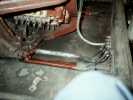 |
 |
The view from the fireman's side shows 2 of the
12 the brush holders. The heat lamp was being used to dry the freshly applied
red insulating varnish (Glyptol) on the negative buss bar. The set of large
relays in the bottom of the electrical cabinet to the left are the transition
relays. There are covers which normally enclose the main generator but
they have been removed in order to clean out the gunk under the main generator
and re-insulate the buss bars.
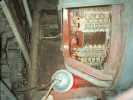 |
It is not unusual for locomotives to trip their
ground relay when cranking (starting) is taking place. This happens because
any grounded wire in the battery system, and there are miles of wire in
there, will be connected to the main generator through the start field
during cranking. The 3189 suffered from this malady because of the nasty
type of wire that was used during GRIP. I fought low voltage grounds for
quite some time and replaced a lot of wire in the process.
 |
 |
In the spring of 1990 and again in 1993, the Oakland
Army Base held an open house called "Railroad Heritage Days". Various equipment
was brought in by the area railroads and in 1993, the 3189 was a participant.
Displaying her old Del Monte number, she was an unexpected sight for the
crowds and great fun for us to exhibit. Of course, that's me in the cab,
grinning like an idiot. Later in the day, Errol and I are discussing
something that will no doubt cost us money. Rod Ciganovich photos.
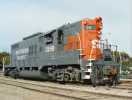 |
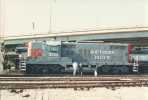 |
This photo is a study in apprehension. The first
trip out in official service on the OTR was a tense experience for me.
That's me, photo left, with switchman Brian Copple listening for any strange
noise or cry of help from the engineer. The 3189 stayed in service for
nearly a year while I painted and refurbished the ABL 44 while the OTR
97 is was in service on the Alameda Belt Line. Bill Wilson photo, collection
of Fred James.
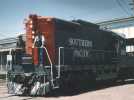 |
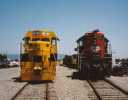 |
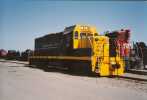 |
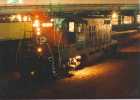 |
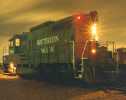 |